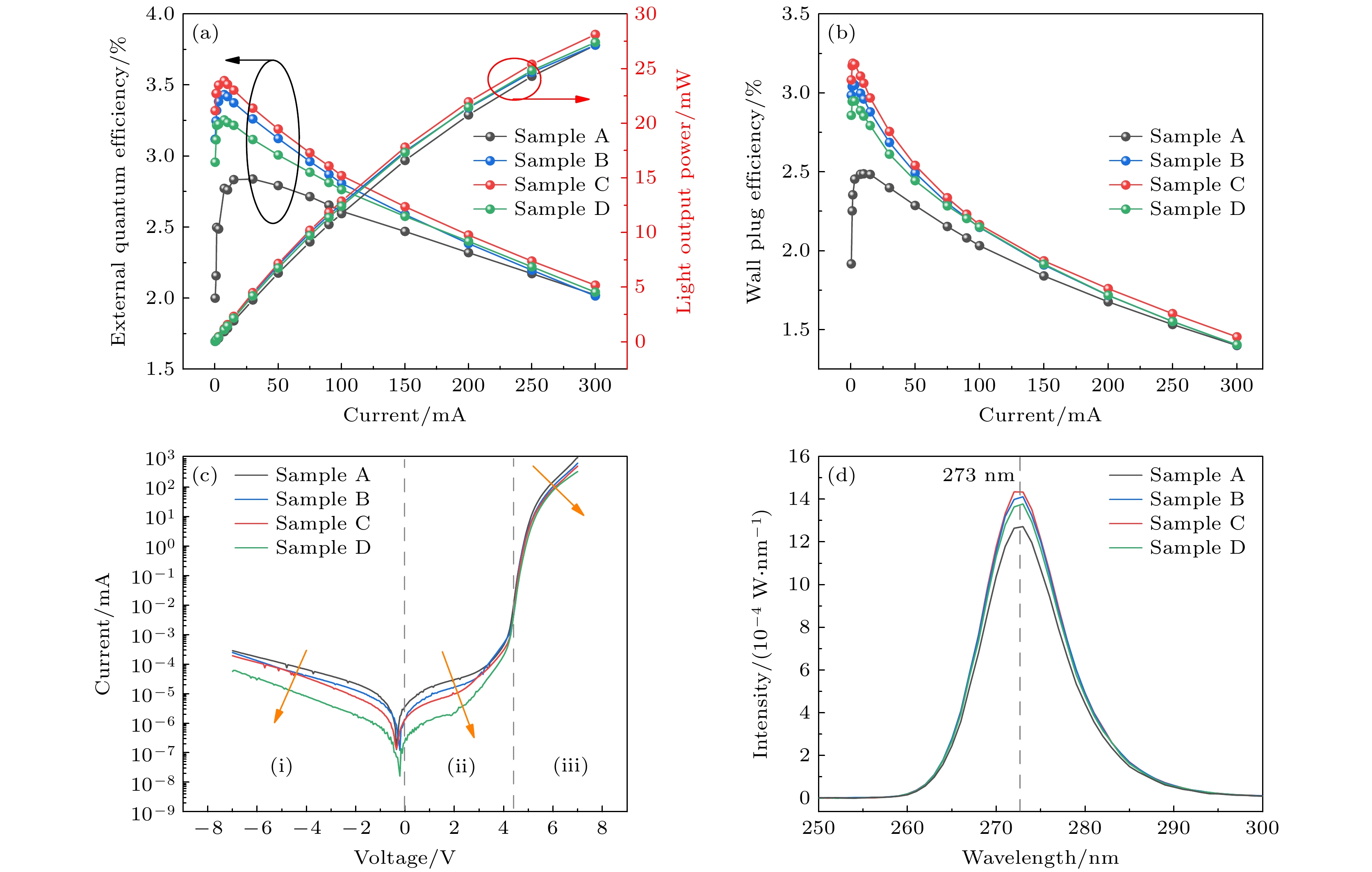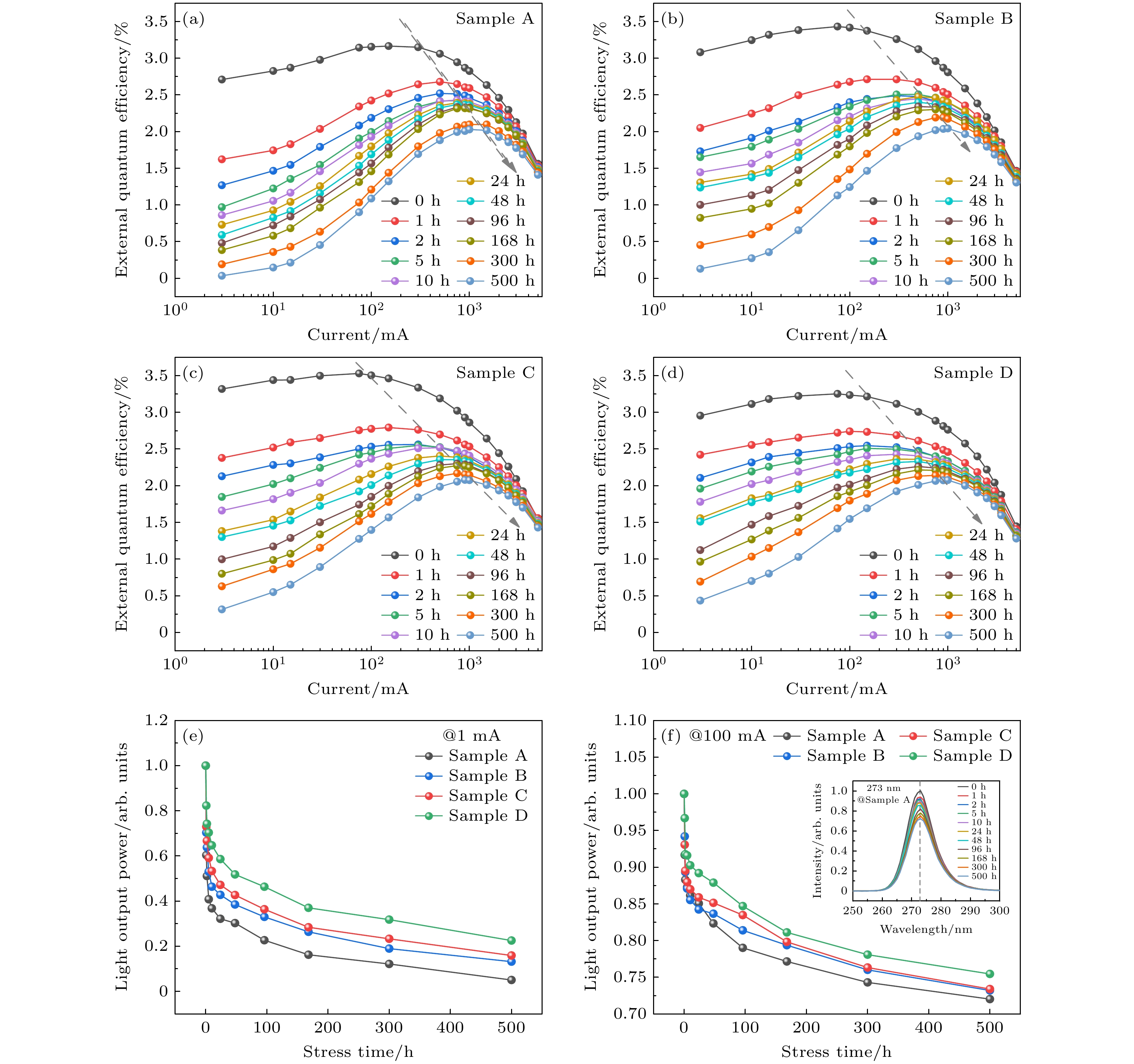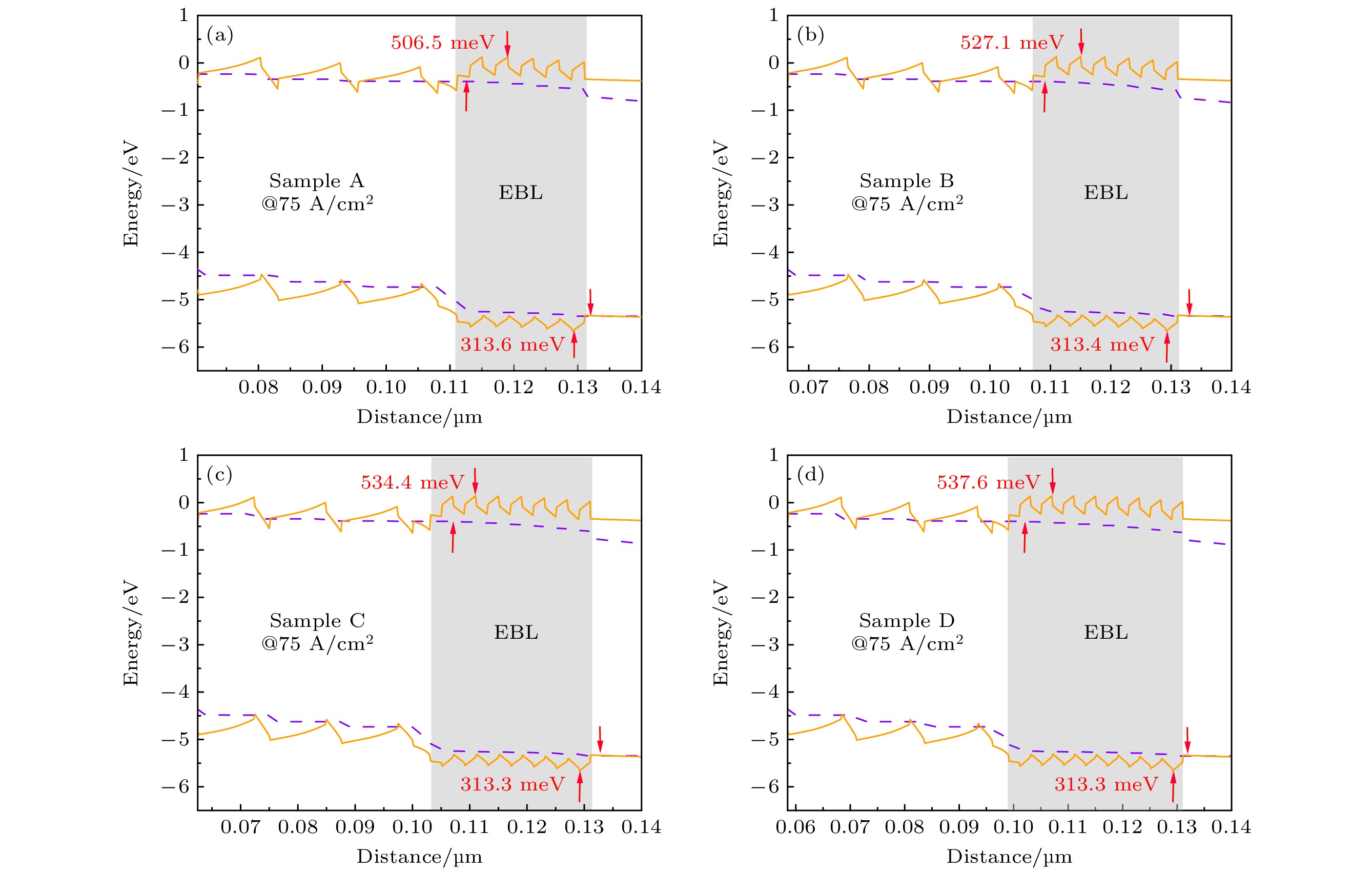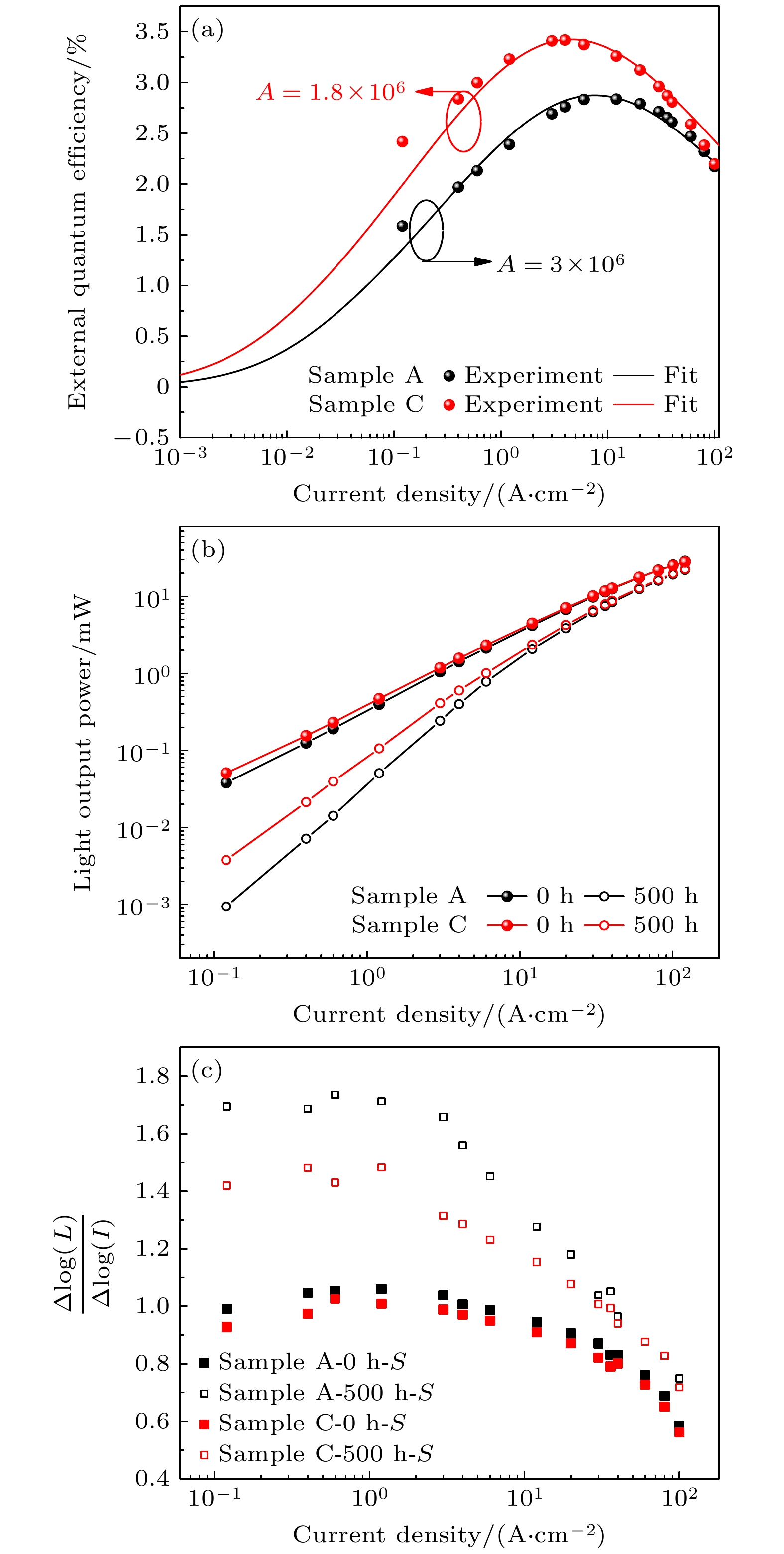-
在AlGaN基深紫外发光二极管(DUV-LEDs)中设计了具有不同周期数的超晶格电子阻挡层(SL-EBL)结构, 研究了SL-EBL周期数对DUV-LEDs发光效率、I-V特性、可靠性及有源区载流子复合机制的影响. 研究结果表明, 随着SL-EBL的周期数增加, DUV-LEDs的光输出功率(LOP)、外量子效率(EQE)和电光转换效率 (WPE)均呈先上升后下降的趋势, 同时泄漏电流减小, 可靠性提升. 当周期数为7时(厚度为28 nm), DUV-LEDs裸芯的EQE和WPE均达到最大值, 在7.5 mA注入电流下分别为3.5%和3.2%. 能带模拟结果证明了增加SL-EBL周期数可以有效提升电子势垒高度, 而几乎不改变空穴势垒高度. 然而, 当SL-EBL超过一定厚度时, 抑制了空穴向有源区的注入, 导致EQE和WPE随SL-EBL周期数变化出现拐点. 研究了SL-EBL周期数对DUV-LEDs载流子复合机制的影响, 发现增加SL-EBL周期数可以有效地降低有源区内载流子非辐射复合.The development of AlGaN-based deep ultraviolet light emitting diodes (DUV-LEDs) is currently limited by poor external quantum efficiency (EQE) and wall-plug efficiency (WPE). Internal quantum efficiency (IQE), as an important component of EQE, plays a crucial role in improving the performance of DUV-LEDs. The IQE is related to the carrier injection efficiency and the radiation recombination rate in the active region. In order to improve the IQE of AlGaN-based DUV-LEDs, this work proposes a scheme to optimize the period number of superlattice electron barrier layer (SL-EBL) to achieve better carrier injection efficiency and confinement capability. The effect of the period number of SL-EBL on the luminous efficiency, reliability and carrier recombination mechanism of AlGaN-based DUV-LEDs with an emission wavelength of 273 nm are investigated. The experimental results show that the light output power (LOP), external quantum efficiency (EQE) and wall-plug efficiency (WPE) of the DUV-LEDs tend to first increase and then decrease with the period number of SL-EBL increasing, while the leakage current decreases and the reliability is enhanced. The maximum EQE and WPE of the DUV-LED are 3.5% and 3.2%, respectively, at an injection current of 7.5 mA when the period number of SL-EBL is fixed at 7 (the thickness is 28 nm). Meanwhile, the numerical simulation results show that the electron potential barrier height is enhanced with the period number of SL-EBL increasing, and the variation of the hole potential barrier height is negligible. Therefore, increasing the period number of SL-EBL is beneficial to shielding the dislocations and suppressing the leakage of electrons into the p-type layer, which improves the luminous efficiency and reliability of DUV-LEDs. However, when the period number of SL-EBL exceeds 7, the excessively thick hole potential barrier prevents the holes from entering into the activation region and reduces the radiative recombination efficiency. Therefore, EQE and WPE will show an inflection point with the variation of the period number of SL-EBL. In addition, to investigate the carrier recombination mechanism of the active region, the experimental EQE curves are fitted by the ABC model as well as the different slopes in logarithmic light output power-current (L-I ) curves are calculated after aging. It can be found that increasing the period number of SL-EBL can effectively suppress the non-radiative combination of carriers in the active region. This investigation can provide an alternative way to enhance the photoelectric performance of DUV-LEDs.
-
Keywords:
- deep ultraviolet light emitting diodes /
- electron barrier layer /
- reliability /
- external quantum efficiency
[1] 冯丽雅, 路慧敏, 朱一帆, 陈毅勇, 于彤军, 王建萍 2023 物理学报 72 048502
 Google Scholar
Google Scholar
Feng L Y, Lu H M, Zhu Y F, Chen Y Y, Yu T J, Wang J P 2023 Acta Phys. Sin. 72 048502
 Google Scholar
Google Scholar
[2] Kneissl M, Seong T Y, Han J, Amano H 2019 Nat. Photonics 13 233
 Google Scholar
Google Scholar
[3] Du P, Shi L, Liu S, Zhou S J 2022 Micro Nanostruct. 163 107150
 Google Scholar
Google Scholar
[4] Hu H, Zhou S, Liu X T, Gao Y L, Gui C Q, Liu S 2017 Sci. Rep. 7 44627
 Google Scholar
Google Scholar
[5] Sharif M N, Niass M I, Liou J J, Wang F, Liu Y 2021 Superlattice. Microstruct. 158 107022
 Google Scholar
Google Scholar
[6] Nagasawa Y, Hirano A 2018 Appl. Sci. (Basel) 8 1264
 Google Scholar
Google Scholar
[7] Zhang D Y, Chu C S, Tian K K, Kou J Q, Bi W G, Zhang Y H, Zhang Z H 2020 AIP Adv. 10 065032
 Google Scholar
Google Scholar
[8] Lobo-Ploch N, Mehnke F, Sulmoni L, Cho H K, Guttmann M, Glaab J, Hilbrich K, Wernicke T, Einfeldt S, Kneissl M 2020 Appl. Phys. Lett. 117 111102
 Google Scholar
Google Scholar
[9] Sun Y H, Xu F J, Xie N, Wang J M, Zhang N, Lang J, Liu B Y, Fang X Z, Wang L B, Ge W K, Kang X N, Qin Z X, Yang X L, Wang X Q, Shen B 2020 Appl. Phys. Lett. 116 212102
 Google Scholar
Google Scholar
[10] Hu H P, Tang B, Wan H, Sun H D, Zhou S J, Dai J N, Chen C Q, Liu S, Guo L J 2020 Nano Energy 69 104427
 Google Scholar
Google Scholar
[11] Meneghini M, La Grassa M, Vaccari S, Galler B, Zeisel R, Drechsel P, Hahn B, Meneghesso G, Zanoni E 2014 Appl. Phys. Lett. 104 113505
 Google Scholar
Google Scholar
[12] Tian K K, Chu C S, Shao H, Che J M, Kou J Q, Fang M Q, Zhang Y H, Bi W G, Zhang Z H 2018 Superlattice. Microstruct. 122 280
 Google Scholar
Google Scholar
[13] Sun J, Sun H Q, Yi X Y, Yang X, Liu T Y, Wang X, Zhang X, Fan X C, Zhang Z D, Guo Z Y 2017 Superlattice. Microstruct. 107 49
 Google Scholar
Google Scholar
[14] Yu H B, Chen Q, Ren Z J, Tian M, Long S B, Dai J N, Chen C Q, Sun H D 2019 IEEE Photonics J. 11 1
 Google Scholar
Google Scholar
[15] Cao Y W, Lv Q J, Yang T P, Mi T T, Wang X W, Liu W, Liu J L 2023 Micro Nanostruct. 175 207489
 Google Scholar
Google Scholar
[16] So B, Kim J, Kwak T, Kim T, Lee J, Choi U, Nam O 2018 RSC Adv. 8 35528
 Google Scholar
Google Scholar
[17] Zhao F Y, Wei J, Dong H L, Jia Z G, Li T B, Yu C Y, Zhang Z X, Xu B S 2022 Aip Adv. 12 125003
 Google Scholar
Google Scholar
[18] Wang L Y, He W, Zheng T, Chen Z X, Zheng S W 2019 Superlattice. Microstruct. 133 106188
 Google Scholar
Google Scholar
[19] Usman M, Jamil T, Malik S, Jamal H 2021 Optik 232 166528
 Google Scholar
Google Scholar
[20] Cao Y W, Lv Q J, Yang T P, Mi T T, Wang X W, Liu W, Liu J L 2023 J. Lumin. 257 119699
 Google Scholar
Google Scholar
[21] Kim K S, Han D P, Kim H S, Shim J I 2014 Appl. Phys. Lett. 104 091110
 Google Scholar
Google Scholar
[22] Cao X A, Teetsov J M, D’evelyn M P, Merfeld D W, Yan C H 2004 Appl. Phys. Lett. 85 7
 Google Scholar
Google Scholar
[23] 王福学, 叶煊超 2017 发光学报 38 6
 Google Scholar
Google Scholar
Wang F X, Ye X C 2017 Chin. J. Lumin. 38 6
 Google Scholar
Google Scholar
[24] Schubert M F, Schubert E F 2010 Appl. Phys. Lett. 96 131102
 Google Scholar
Google Scholar
[25] Lv Q J, Gao J D, Tao X X, Zhang J L, Mo C L, Wang X L, Zheng C D, Liu J L 2020 J. Lumin. 222 117186
 Google Scholar
Google Scholar
[26] Grillot P N, Krames M R, Zhao H, Teoh S H 2006 IEEE Trans. Device Mater. Rel. 6 564
 Google Scholar
Google Scholar
[27] 毛清华, 江风益, 程海英, 郑畅达 2010 物理学报 59 8078
 Google Scholar
Google Scholar
Mao Q H, Jiang F Y, Cheng H Y, Zheng C D 2010 Acta Phys. Sin. 59 8078
 Google Scholar
Google Scholar
[28] Dai Q, Shan Q F, Wang J, Chhajed S, Cho J, Schubert E F, Crawford M H, Koleske D D, Kim M H, Park Y 2010 Appl. Phys. Lett. 97 133507
 Google Scholar
Google Scholar
[29] Yun J, Shim J I, Hirayama H 2015 Appl. Phys. Express 3 8 022104
 Google Scholar
Google Scholar
[30] Cao X A, Stokes E B, Sandvik P M, Leboeuf S F, Kretchmer J, Walker D 2002 IEEE Electr. Device Lett. 23 535
 Google Scholar
Google Scholar
[31] Lv Q J, Liu J L, Mo C L, Zhang J L, Wu X M, Wu Q F, Jiang F Y 2019 ACS Photonics 6 130
 Google Scholar
Google Scholar
[32] Yamaguchi M, Yamamoto A, Tachikawa M, Itoh Y, Sugo M 1988 Appl. Phys. Lett. 53 2293
 Google Scholar
Google Scholar
-
图 2 不同SL-EBL周期数样品的实验结果 (a)光输出功率以及外量子效率随电流的变化; (b)电光转换效率随电流的变化; (c) I-V曲线; (d)在100 mA注入电流下发光强度随峰值波长的变化
Fig. 2. Experimental results for different samples: (a) LOP, EQE and (b) WPE as a function of current density; (c) experimentally measured I-V curves in logarithmic coordinates; (d) EL emission spectrums of DUV-LEDs at 100 mA.
图 3 (a)—(d)不同老化时间下样品A, B, C和D的 EQE 随电流的变化; 具有不同SL-EBL周期数的样品A, B, C和D在老化过程中测得的在(e)小电流以及(f)工作电流下的归一化光输出功率, (f)中插图为样品A在不同老化时间下的归一化电致发光光谱
Fig. 3. The EQE characteristic curves of samples (a) A, (b) B, (c) C, and (d) D after aging; (e) the normalized output power of (e) low injection current and (f) working current of samples A, B, C and D during aging period; the illustration in panel (f) shows the electroluminescence spectra of sample A under different stress time.
图 5 (a)样品A和样品C的 EQE曲线与ABC模型的理论拟合, 其中实验数据用点表示, ABC模型拟合数据用实线表示; (b)样品A和样品C在老化前后双对数坐标L-I 曲线; (c)样品A和样品C在老化前后的S值
Fig. 5. (a) Experimentally measured EQE vs. current density (solid dot) and theoretical ABC model (solid line) fits for sample A and C; (b) LOP and (c) slope (S ) as functions of current density for sample A and C.
-
[1] 冯丽雅, 路慧敏, 朱一帆, 陈毅勇, 于彤军, 王建萍 2023 物理学报 72 048502
 Google Scholar
Google Scholar
Feng L Y, Lu H M, Zhu Y F, Chen Y Y, Yu T J, Wang J P 2023 Acta Phys. Sin. 72 048502
 Google Scholar
Google Scholar
[2] Kneissl M, Seong T Y, Han J, Amano H 2019 Nat. Photonics 13 233
 Google Scholar
Google Scholar
[3] Du P, Shi L, Liu S, Zhou S J 2022 Micro Nanostruct. 163 107150
 Google Scholar
Google Scholar
[4] Hu H, Zhou S, Liu X T, Gao Y L, Gui C Q, Liu S 2017 Sci. Rep. 7 44627
 Google Scholar
Google Scholar
[5] Sharif M N, Niass M I, Liou J J, Wang F, Liu Y 2021 Superlattice. Microstruct. 158 107022
 Google Scholar
Google Scholar
[6] Nagasawa Y, Hirano A 2018 Appl. Sci. (Basel) 8 1264
 Google Scholar
Google Scholar
[7] Zhang D Y, Chu C S, Tian K K, Kou J Q, Bi W G, Zhang Y H, Zhang Z H 2020 AIP Adv. 10 065032
 Google Scholar
Google Scholar
[8] Lobo-Ploch N, Mehnke F, Sulmoni L, Cho H K, Guttmann M, Glaab J, Hilbrich K, Wernicke T, Einfeldt S, Kneissl M 2020 Appl. Phys. Lett. 117 111102
 Google Scholar
Google Scholar
[9] Sun Y H, Xu F J, Xie N, Wang J M, Zhang N, Lang J, Liu B Y, Fang X Z, Wang L B, Ge W K, Kang X N, Qin Z X, Yang X L, Wang X Q, Shen B 2020 Appl. Phys. Lett. 116 212102
 Google Scholar
Google Scholar
[10] Hu H P, Tang B, Wan H, Sun H D, Zhou S J, Dai J N, Chen C Q, Liu S, Guo L J 2020 Nano Energy 69 104427
 Google Scholar
Google Scholar
[11] Meneghini M, La Grassa M, Vaccari S, Galler B, Zeisel R, Drechsel P, Hahn B, Meneghesso G, Zanoni E 2014 Appl. Phys. Lett. 104 113505
 Google Scholar
Google Scholar
[12] Tian K K, Chu C S, Shao H, Che J M, Kou J Q, Fang M Q, Zhang Y H, Bi W G, Zhang Z H 2018 Superlattice. Microstruct. 122 280
 Google Scholar
Google Scholar
[13] Sun J, Sun H Q, Yi X Y, Yang X, Liu T Y, Wang X, Zhang X, Fan X C, Zhang Z D, Guo Z Y 2017 Superlattice. Microstruct. 107 49
 Google Scholar
Google Scholar
[14] Yu H B, Chen Q, Ren Z J, Tian M, Long S B, Dai J N, Chen C Q, Sun H D 2019 IEEE Photonics J. 11 1
 Google Scholar
Google Scholar
[15] Cao Y W, Lv Q J, Yang T P, Mi T T, Wang X W, Liu W, Liu J L 2023 Micro Nanostruct. 175 207489
 Google Scholar
Google Scholar
[16] So B, Kim J, Kwak T, Kim T, Lee J, Choi U, Nam O 2018 RSC Adv. 8 35528
 Google Scholar
Google Scholar
[17] Zhao F Y, Wei J, Dong H L, Jia Z G, Li T B, Yu C Y, Zhang Z X, Xu B S 2022 Aip Adv. 12 125003
 Google Scholar
Google Scholar
[18] Wang L Y, He W, Zheng T, Chen Z X, Zheng S W 2019 Superlattice. Microstruct. 133 106188
 Google Scholar
Google Scholar
[19] Usman M, Jamil T, Malik S, Jamal H 2021 Optik 232 166528
 Google Scholar
Google Scholar
[20] Cao Y W, Lv Q J, Yang T P, Mi T T, Wang X W, Liu W, Liu J L 2023 J. Lumin. 257 119699
 Google Scholar
Google Scholar
[21] Kim K S, Han D P, Kim H S, Shim J I 2014 Appl. Phys. Lett. 104 091110
 Google Scholar
Google Scholar
[22] Cao X A, Teetsov J M, D’evelyn M P, Merfeld D W, Yan C H 2004 Appl. Phys. Lett. 85 7
 Google Scholar
Google Scholar
[23] 王福学, 叶煊超 2017 发光学报 38 6
 Google Scholar
Google Scholar
Wang F X, Ye X C 2017 Chin. J. Lumin. 38 6
 Google Scholar
Google Scholar
[24] Schubert M F, Schubert E F 2010 Appl. Phys. Lett. 96 131102
 Google Scholar
Google Scholar
[25] Lv Q J, Gao J D, Tao X X, Zhang J L, Mo C L, Wang X L, Zheng C D, Liu J L 2020 J. Lumin. 222 117186
 Google Scholar
Google Scholar
[26] Grillot P N, Krames M R, Zhao H, Teoh S H 2006 IEEE Trans. Device Mater. Rel. 6 564
 Google Scholar
Google Scholar
[27] 毛清华, 江风益, 程海英, 郑畅达 2010 物理学报 59 8078
 Google Scholar
Google Scholar
Mao Q H, Jiang F Y, Cheng H Y, Zheng C D 2010 Acta Phys. Sin. 59 8078
 Google Scholar
Google Scholar
[28] Dai Q, Shan Q F, Wang J, Chhajed S, Cho J, Schubert E F, Crawford M H, Koleske D D, Kim M H, Park Y 2010 Appl. Phys. Lett. 97 133507
 Google Scholar
Google Scholar
[29] Yun J, Shim J I, Hirayama H 2015 Appl. Phys. Express 3 8 022104
 Google Scholar
Google Scholar
[30] Cao X A, Stokes E B, Sandvik P M, Leboeuf S F, Kretchmer J, Walker D 2002 IEEE Electr. Device Lett. 23 535
 Google Scholar
Google Scholar
[31] Lv Q J, Liu J L, Mo C L, Zhang J L, Wu X M, Wu Q F, Jiang F Y 2019 ACS Photonics 6 130
 Google Scholar
Google Scholar
[32] Yamaguchi M, Yamamoto A, Tachikawa M, Itoh Y, Sugo M 1988 Appl. Phys. Lett. 53 2293
 Google Scholar
Google Scholar
计量
- 文章访问数: 4597
- PDF下载量: 116
- 被引次数: 0













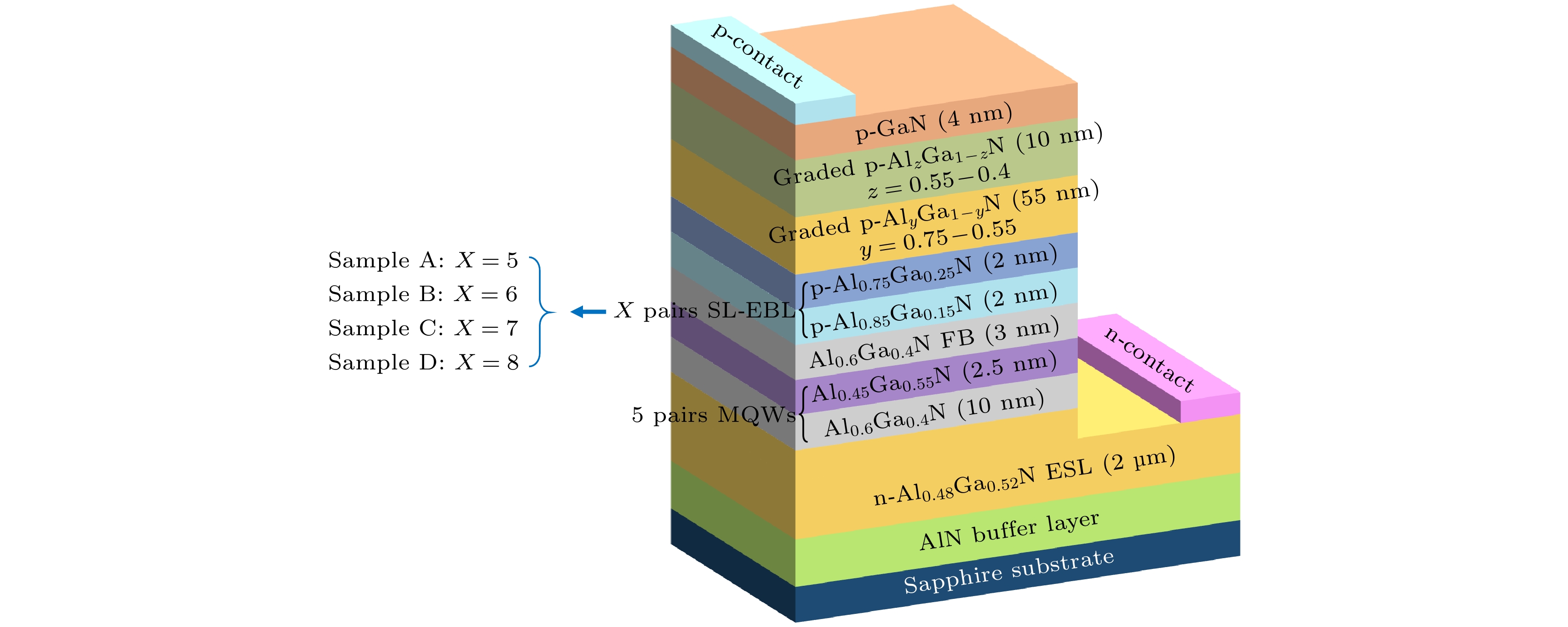
 下载:
下载:
